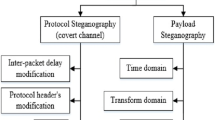Abstract
Quantization index modulation (QIM) is a commonly used steganography method exploiting redundancy in codebook quantization procedure of signal encoding. The feasibility of steganography based on QIM depends on codebook division algorithm which mainly determines embedding capacity, latency and complexity of embedding and extracting algorithm. A novel neighbor-index-division (NID) codebook division method with a simple and more security implementation for G.723.1 speech streams is proposed. Differing from existing complementary neighbor vertices (CNV) algorithm, NID divides neighbor-indexed codewords into separated sub-codebooks (partitions) combined with a suitable stego coding strategy. Moreover, NID method makes multiple division (k sub-codebooks, k ≥ 3) for one single codebook possible, thus increases embedding capacity. To take full advantage of the partitions especially for odd-numbered division, multi-ary coding strategy is introduced in embedding and extracting procedures. Experimental results demonstrate that proposed method has almost the same distortion compared with CNV in binary division condition but a much easier implementation and introduces flexible multiple division methods which is more suitable for practical covert communication applications. Further, by applying a commonly used COV(1, 3, 2) stego coding strategy, NID is able to resist the state-of-art steganalysis towards QIM with a still practical embedding rate.




Similar content being viewed by others
References
Cai Y, Wang J (2013) Differential Evolution with neighborhood and direction information for numerical optimization. IEEE Trans Cybern 43(6):2202–2215
Cai Y, Wang J, Chen Y, Wang T, Tian H, Luo W (2014) Adaptive direction information in differential evolution for numerical optimization. Soft Comput (In press)
Castiglione A, D’Alessio B, Soriente C (2007) Taking advantages of a disadvantage: digital forensics and steganography using document metadata. J Syst Softw 80(5):750–764
Castiglione A, D’Alessio B, De Santis A (2011) Steganography and secure communication on online social networks and online photo sharing. In: International conference on broadband and wireless computing, communication and applications (BWCCA), 2011. IEEE, New York, pp 363–368
Chen B, Wornell G (2001) Quantization index modulation: a class of provably good methods for digital watermarking and information embedding. IEEE Trans Inf Theory 47(4):1423–1443
Huang Y, Tang S, Yuan J (2011) Steganography in inactive frames of VoIP streams encoded by source codec. IEEE Trans Inf Forensics Secur 6(2):296–306
ITU-T Rec. G.723.1 (2006) Dual rate speech coder for multimedia communications transmitting at 5.3 and 6.3 kbit/s
ITU-T Rec. P.800.1 (2006) Mean opinion score (MOS) terminology
ITU-T Rec. P.800 (1996) Methods for subjective determination of transmission quality
ITU-T Rec. P.862 (2001) Perceptual evaluation of speech quality (PESQ): an objective method for end-to-end speech quality assessment of narrow-band telephone networks and speech codecs
Li J, Wang Q, Wang C, Cao N, Ren K, Lou W (2010) Fuzzy keyword search over encrypted data in cloud computing. In: 29th IEEE international conference on computer communications (INFOCOM), 2010. IEEE, New York, pp 441–445
Li S, Tao H, Huang Y (2012) Detection of QIM steganography in G.723.1 bit stream based on quantization index sequence analysis. J Zhejiang Univ Sci C 13(8):624–634
Li J, Huang X, Li J, Chen X, Xiang Y (2014) Securely outsourcing attribute-based encryption with checkability. IEEE Trans Parallel Distrib Syst 25(8):2201–2210
Liu J, Zhou K, Tian H (2012) Least-significant-digit steganography in low bitrate speech. In: Proceedings of the IEEE international conference on communications (ICC), 2012. IEEE, New York, pp 1133–1337
Liu J, Tian H, Zhou K (2014) Frame-bitrate-change based steganography for voice-over-IP. J Central South Univ 21(12):4544–4552
Mazurczyk W, Szczypiorski K (2008a) Covert channels in SIP for VoIP signaling. Global E-Secur 12:65–72
Mazurczyk W, Szczypiorski K (2008b) Steganography of VoIP streams. Lect Notes Comput Sci 5332(2):1001–1018
Pascal V (2013) Code based cryptography and steganography. In: Fifth international conference on algebraic informatics, 2013, vol 8080, pp 9–46
Tian H, Zhou K, Feng D (2010) Dynamic matrix encoding strategy for voice-over-IP steganography. J Central South Univ Technol 17(6):1285–1292
Tian H, Jiang H, Zhou K, Feng D (2011) Adaptive partial-matching steganography for voice over ip using triple m sequences. Comput Commun 34(18):2236–2247
Tian H, Liu J, Li S (2013) Improving security of quantization-index-modulation steganography in low bit-rate speech streams. Multimed Syst 1–12
Wang J, Cai Y (2015) Multiobjective evolutionary algorithm for frequency assignment problem in satellite communications. Soft Comput 19(5):1229–1253
Wang F, Jain L, Pan J (2007) VQ-based watermarking scheme with genetic codebook partition. J Netw Comput Appl 30(1):4–23
Wei Z, Zhao B, Liu B, Su J, Xu L, Xu E (2014) A novel steganography approach for voice over IP. J Ambient Intell Human Comput 5:601–610
Xiao B, Huang Y, Tang S (2008) An approach to information hiding in low bit-rate speech stream. In: Proceedings of the IEEE global telecommunications conference (GLOBECOM), 2008. IEEE, New York, pp 1940–1944
Yargicoglu A, Ilk H (2010) Hidden data transmission in mixed excitation linear prediction coded speech using quantisation index modulation. IET Inf Secur 4(3):158–166
Ying L, Huang Y, Yuan J, Linda B (2012) A novel covert timing channel based on RTP/RTCP. Chin J Electron 21(4):711–714
Zhou K, Liu J, Tian H, Li C (2012) State-based steganography in low bit rate speech. In: Proceedings of the 20th ACM international conference on multimedia (ACMMM), 2012. ACM, New York, pp 1109–1112
Acknowledgments
The work described in this paper is supported in part by Natural Science Foundation of China (61302094, 61572206 and U1405254), Natural Science Foundation of Fujian Province of China (2014J01238), Education and Science Research Program for Young and Middle-aged Teacher of Fujian Province of China (JA13012), Promotion Program for Young and Middle-aged Teacher in Science and Technology Research of Huaqiao University (ZQN-PY115), Program for Science & Technology Innovation Teams and Leading Talents of Huaqiao University (2014KJTD13), Research Program for Outstanding Young Teachers in Higher Education Institutions of Fujian Province of China under grant no. MJK20 and the Fundamental Research Funds for the Central Universities (14BS210).
Author information
Authors and Affiliations
Corresponding author
Rights and permissions
About this article
Cite this article
Liu, J., Tian, H., Lu, J. et al. Neighbor-index-division steganography based on QIM method for G.723.1 speech streams. J Ambient Intell Human Comput 7, 139–147 (2016). https://doi.org/10.1007/s12652-015-0315-6
Received:
Accepted:
Published:
Issue Date:
DOI: https://doi.org/10.1007/s12652-015-0315-6




